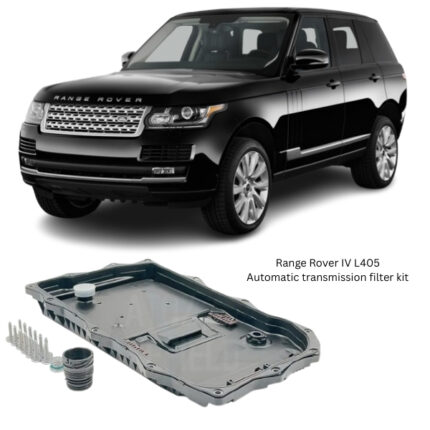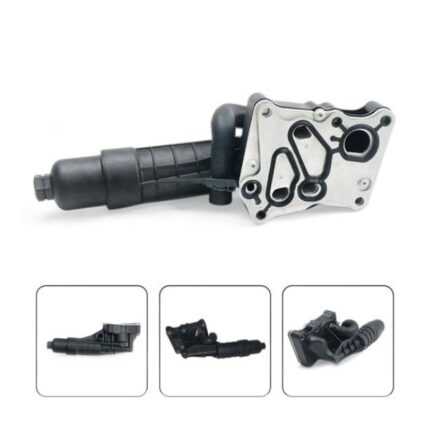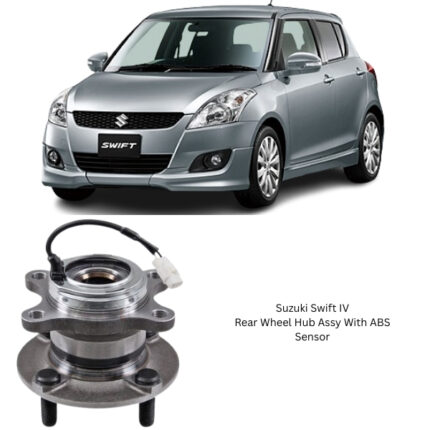Get Suzuki Swift IV 4WD Rear Wheel Hub Assy With ABS Sensor 43402-71L50 in Kenya
The rear wheel hub assembly with ABS sensor is a vital component in the drivetrain and braking system of modern vehicles. It plays a central role in ensuring the wheels rotate smoothly while also integrating advanced safety technology through the Anti-lock Braking System (ABS). By combining mechanical strength with electronic precision, the rear wheel hub assembly with ABS sensor represents the evolution of automotive engineering, designed to improve driving stability, safety, and overall vehicle performance.
1. Function and Purpose
At its core, the wheel hub assembly serves as the mounting point for the wheel and tire. It allows the wheel to rotate freely while keeping it securely attached to the vehicle’s suspension. The assembly houses the wheel bearings, which reduce friction and enable smooth rotation.
The addition of the ABS sensor enhances the hub’s functionality by monitoring wheel speed and relaying data to the ABS control unit. This integration ensures optimal braking performance, particularly under emergency stops or slippery conditions.
Together, the rear wheel hub assembly with ABS sensor fulfills two primary purposes:
-
Mechanical Support – Bearing the vehicle’s weight and providing smooth wheel rotation.
-
Electronic Safety – Collecting and transmitting real-time wheel speed data for ABS and stability control systems.
2. Construction and Design
The rear wheel hub assembly with ABS sensor is an integrated unit combining mechanical and electronic components. Its design typically includes:
-
Hub Flange – The flat mounting surface where the wheel and brake rotor are attached with lug nuts or bolts.
-
Wheel Bearing – A precision-engineered bearing housed inside the hub, allowing friction-free rotation.
-
Housing – A durable metal casing that secures the bearing and protects it from contaminants such as dust, dirt, and moisture.
-
ABS Sensor – An electronic sensor embedded within or attached to the hub, responsible for detecting wheel speed.
-
Tone Ring/Reluctor Ring – A toothed ring or magnetic encoder located within the hub that interacts with the ABS sensor to generate wheel speed signals.
The materials used in construction are typically hardened steel for the bearing and housing, ensuring durability, and high-grade alloys for components exposed to stress and heat. The ABS sensor is encased in protective materials to withstand harsh environmental conditions.
3. Role of the ABS Sensor
The ABS sensor is the technological highlight of this assembly. It functions by detecting the rotation speed of the wheel through magnetic or toothed signals from the tone ring. This data is continuously sent to the ABS control module, which uses the information to:
-
Prevent wheel lock-up during hard braking.
-
Improve traction by modulating brake pressure on slippery roads.
-
Support stability control and advanced safety systems like electronic brake-force distribution (EBD) and traction control.
Without the ABS sensor, the wheel hub assembly would simply provide mechanical support. With it, the component becomes part of a sophisticated safety network.
4. Importance in Vehicle Safety and Performance
The rear wheel hub assembly with ABS sensor is not just about wheel rotation—it contributes directly to driving safety and comfort. Its importance can be summarized as follows:
-
Stability: Ensures that the wheels rotate smoothly and evenly, reducing vibrations.
-
Control: Provides accurate wheel speed data for responsive ABS and stability systems.
-
Safety: Reduces the risk of wheel lock-up and skidding during emergency braking.
-
Longevity: Properly functioning bearings minimize tire wear and improve suspension life.
A faulty hub or sensor compromises not only comfort but also braking efficiency, posing significant safety risks.
5. Common Symptoms of Wear or Failure
Over time, the rear wheel hub assembly and ABS sensor may deteriorate due to stress, contamination, or normal wear. Symptoms of failure include:
-
Grinding or humming noise: Caused by worn bearings.
-
Vibrations in the wheel or steering: Indicating bearing looseness or damage.
-
ABS warning light on the dashboard: Signaling a malfunctioning sensor.
-
Reduced braking efficiency: Due to faulty ABS data.
-
Uneven tire wear: From improper wheel rotation or misalignment.
Ignoring these symptoms can lead to further damage and unsafe driving conditions.
6. Maintenance and Longevity
Wheel hub assemblies with ABS sensors are designed to be maintenance-free for most of their lifespan. Unlike traditional wheel bearings that required regular greasing, modern sealed hub assemblies are lubricated for life.
However, several practices can extend their longevity:
-
Regular inspections during tire rotations or brake servicing.
-
Avoiding deep potholes and curbs, which can stress the bearings.
-
Keeping ABS components clean, as dirt and debris can interfere with the sensor’s performance.
-
Replacing faulty components promptly, preventing further damage to the drivetrain or braking system.
Most rear wheel hub assemblies last between 130,000 to 160,000 kilometers, though harsh driving conditions may shorten this span.
7. Replacement Considerations
When the rear wheel hub assembly or ABS sensor fails, replacement is the only viable option. Because the hub is a sealed unit, repairs are not practical. Replacement involves:
-
Removing the wheel and brake components.
-
Detaching the faulty hub assembly from the suspension knuckle.
-
Disconnecting the ABS sensor wiring.
-
Installing the new hub assembly and reconnecting the sensor.
-
Ensuring proper torque on bolts and lug nuts.
-
Clearing any ABS fault codes from the vehicle’s system.
It is highly recommended that a qualified mechanic handle the replacement, as improper installation may cause alignment or safety issues.
8. Types of ABS Sensors in Hub Assemblies
Not all ABS sensors function the same way. In hub assemblies, they generally fall into two categories:
-
Passive Sensors – Use a magnetic pickup and tone ring, generating signals as the wheel rotates.
-
Active Sensors – Use advanced electronics and magnetic encoders, providing more accurate readings at lower speeds.
Modern vehicles increasingly rely on active ABS sensors due to their precision and compatibility with advanced safety systems.
9. Contribution to Driving Comfort
Beyond safety, the rear wheel hub assembly with ABS sensor contributes significantly to driving comfort. A properly functioning hub ensures:
-
Smooth wheel rotation, eliminating vibrations.
-
Quiet operation without humming or grinding noises.
-
Consistent braking performance with responsive ABS control.
-
Stable handling, particularly during sharp turns or on uneven surfaces.
This makes long drives more pleasant and reduces driver fatigue.
Follow us on Facebook for more parts.





Reviews
Clear filtersThere are no reviews yet.